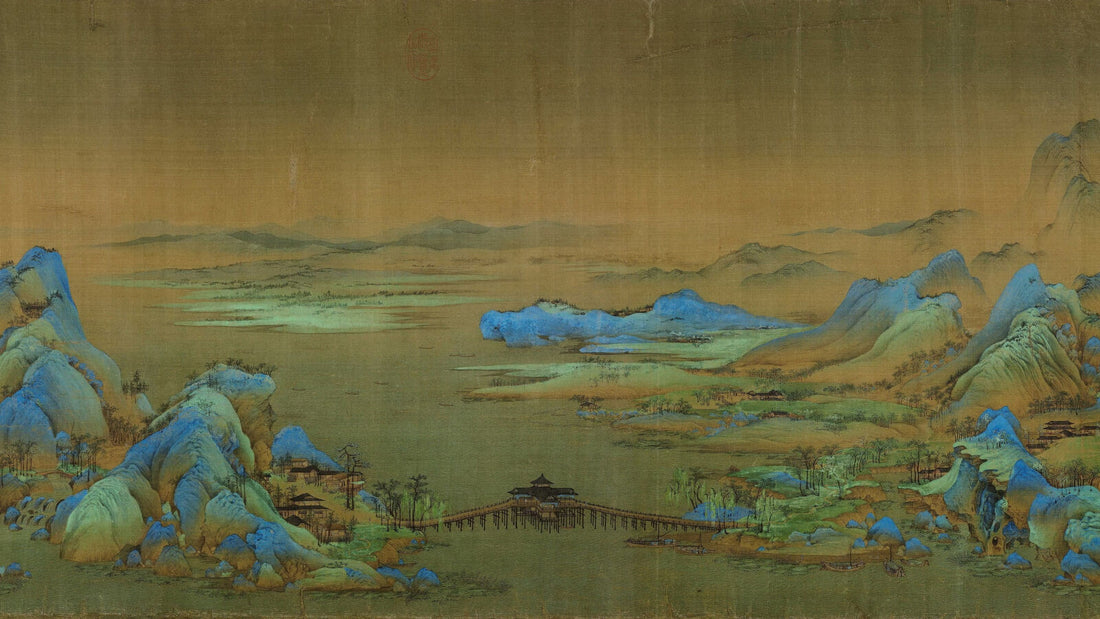
All You Need To Know About “A Thousand Li of Rivers and Mountains” Chinese Artwork
Share
The Landscape Painted by a Prodigy
Words By Qiao Wen, Heritage Advisor of Tang Heritage
Some paintings are quiet echoes. Others are thunder. A Thousand Li of Rivers and Mountains (千里江山圖) is the latter—a sweeping testament to youth, vision, and the boundless spirit of nature, rendered by a prodigious hand that burned bright and brief.
When I first studied the scroll at the Palace Museum in Beijing, I remember standing utterly still before its vast beginning. The mountains, formed in sapphire blues and lush malachite greens, seemed to rise like waves. The further my eyes travelled, the more I was drawn into its rhythms—not of narrative, but of breath. It felt as though the land itself was alive and unfolding in real time.
A Landscape of Grandeur and Grace
Stretching nearly 12 meters in length, the scroll unfolds like a journey through an idealized China—towering mountains, tranquil rivers, winding paths, and quiet pavilions. It is not just a landscape; it is an imagined world. A world where the harmony between humanity and nature is not aspirational but achieved.
I have walked through many landscape scrolls in my life, but this one flows differently. Each peak, each stream, each dwelling is placed with a precision that feels intuitive. Rendered in ink and color on silk, and employing the blue-and-green landscape technique with mineral pigments of azurite and malachite, the painting hums with vitality.
I remember looking closely at one section of forest nestled against a pale green slope. There, almost hidden, a scholar sits beneath a thatched pavilion. A scene barely larger than a coin, and yet it carries a stillness that stayed with me long after I stepped away.
Its layered colors do not merely decorate—they breathe. They move. They endure.
The Wisdom of a Young Hand
What astonishes me most is not just Wang Ximeng’s technical mastery, but his emotional clarity. At only eighteen, he captured not simply a view, but a vision—a realm ordered by benevolence, steadied by beauty.
There is something almost haunting in the thought that this was his only known work. A flash of brilliance under Emperor Huizong’s patronage, followed by silence. And yet what a flame it was.
Each time I revisit this scroll, I see a young artist not caught in ambition, but settled into purpose. His brush was not merely skilled—it was prophetic.
From Scroll to Silk: A Journey Reimagined
When I was invited to help curate this piece into our Tang Heritage scarf collection, I asked myself—how do we carry a twelve-meter dream into a square of silk without losing its depth? The answer was not to compress it, but to reinterpret it.
The scarf draws upon the spirit of the original, adapting sections of the scroll with great sensitivity. The flowing mountains and pavilions are now gently echoed around the borders, creating a landscape that folds and unfurls with every movement of the body.
We chose to preserve the mineral blues and greens but brightened them slightly to reflect light on silk—transforming solemn grandeur into something luminous and wearable. What was once grounded in stillness is now reawakened in motion.
To wear this scarf is not to reproduce the painting, but to walk with it. It becomes a panorama not for the eye alone, but for the senses.
Embark on a Journey Through Silk
Own a fragment of China’s most majestic scroll.
The A Thousand Li of Rivers and Mountains scarf is a tribute to vision beyond age and beauty beyond time.
https://tangheritage.com/products/a-thousand-li-of-rivers-and-mountains-heritage-artwork-silk-scarf
Available in limited pieces—each one a thread in an unending scroll.
